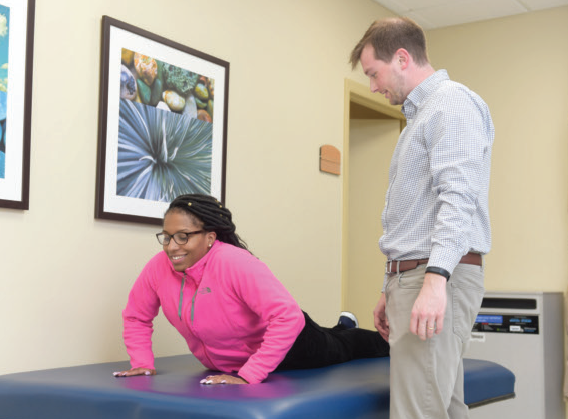
Back pain doesn’t have to be scary. In fact, up to 80 percent of people with back pain can treat their own problem without surgery, injections or medication, says Tim Mahoney, PT, DPT (Doctor of Physical Therapy) and Supervisor, Saint Barnabas Medical Center Rehabilitation at Millburn.
“Research shows that back pain is predominantly movement-and position-related,” Mahoney says. “When that’s the case, the appropriate treatment is movement, position, exercise and activity.”
It’s a surprising approach for many who assume that their back pain is destined to be a chronic medical problem. “Only about 1 percent of back pain is caused by something truly sinister—cancer, a fracture, an infection, a tumor,” Mahoney says.
CAUSE AND EFFECT
“It’s important to understand that back pain is a symptom, not a diagnosis—the same way chest pain can be a symptom of indigestion, a heart attack or something else altogether,” Mahoney says. “When we see a patient with back pain, the goal is to establish what’s causing the underlying problem and treat that issue.”
A skilled physical therapist can assess a patient’s back pain by taking a thorough medical history. “We’ll want to know whether the pain is local or is a referred pain—for example traveling from the back down the leg,” Mahoney says. “Is it constant or intermittent pain? How long has it been going on?”
Serious concerns may arise if the patient describes a change in bowel or bladder habits related to pain, pain at night, or a recent fall or impact to the spine. In those cases, or if a patient feels something serious may be going on with his or her health, a physician should be consulted, Mahoney says.
In the absence of those issues, Mahoney— who is a certified Diplomat (Dip, MDT) in The McKenzie Method of Mechanical Diagnosis and Therapy—will focus on mechanical and musculoskeletal issues. Questions are asked and movements assessed to elicit the patient’s “directional preference.” Simply put, directional preference means some movements and actions, such as bending or sitting, may provoke and worsen pain; moving in another direction, such as by standing or walking, may eliminate the pain.
After a thorough assessment, specific exercises and postures to adopt and to temporarily avoid can be prescribed. This treatment doesn’t involve heat, cold, back braces or medication, and the goal is for it to be practiced by the patient at home.
SELF-HELP
“Often, people think they have pain because they gained weight or they’re getting old, and that’s not necessarily true,” Mahoney says. “We don’t have a clear understanding of what the mechanism is for every kind of back pain. We see young people and fit, athletic people with back pain. We see people who are very active and are on their feet all day, and people living a very sedentary lifestyle.
“What we do know is that frequently, what helps is movement in the opposite direction of the one a person’s body is in for most of the day.”
Mahoney’s goal is to empower patients to control their own back pain. As with any physical issue, the better patients understand it, the better they can prevent and deal with it, he believes. “It’s just like how you don’t have to go to the dentist every time you brush your teeth,” Mahoney says. “You know how to do it. Similarly, when you know the movements you need, you understand what to do when pain comes on and how to prevent it from coming back.”
Saint Barnabas Medical Center offers a Comprehensive Rehabilitation Center at the Barnabas Health Ambulatory Care Center at 200 South Orange Avenue in Livingston, and two outpatient facilities, one in Millburn and one at the JCC MetroWest in West Orange. For more information, call 973.322.7500.